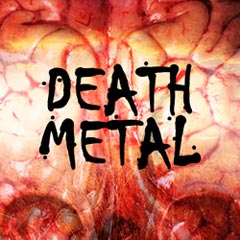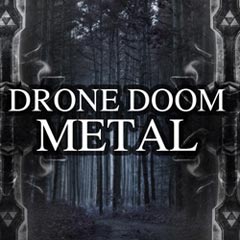Death metal
ON AIR - PROGRAMMING
Double speakers that seem like machine guns, sudden changes in time, violent guitars and guttural voices, all coming straight from hell. Extremely brutal and too refined for its complexity. Have you ever taken the time to listen to Death metal? This intense heavy metal experience is searing and overwhelming, taking you deep into a mystical soundscape. It's percussion thumps with all the fury of a thunderstorm, with distorted guitars that launch 100 nightmarish spikes of rage at once, creating walls of brutality. The vocals echo vitriolic anger, evoking an emotional intensity like nothing else and commanding your full attention. So if you're feeling up for a challenge,test your own limits and expand your horizons by cranking up the volume on Death metal. Death metal is a subgenre of heavy metal music. It is an extreme music, made with distorted and low-tuned instruments, using the technique of palm-muting the guitars and double kick drums to make heav
Enter the Dark and Brutal World of Death Metal
Step into a mystical soundscape filled with blood-curdling vocals, violent guitars, and thunderous percussion. With double speakers that sound like machine guns and sudden changes in time, Death metal is a subgenre of heavy metal that's not for the faint of heart. But for those who dare, it's an intense and overwhelming experience that's both brutal and refined. In this blog post, we'll take a deep dive into the world of Death metal and learn more about this extreme and captivating genre.
Death metal first emerged in the early 1980s, and as the name suggests, it's music that's steeped in themes of death, gore, and violence. At its core, Death metal is about expressing extreme emotions, whether it's anger, hatred, or despair. The music is characterized by its fast-paced rhythms and aggressive vocals, often delivered in a guttural style that can be difficult to understand. But for those who appreciate the artistry, Death metal is a subgenre that's full of creativity and complexity.
One of the defining features of Death metal is its use of distorted and low-tuned instruments, like guitars, bass, and drums. The technique of palm-muting the guitars gives them a staccato sound that's perfect for creating walls of brutality. The double kick drums, meanwhile, give the percussion a machine-gun-like quality that powers the music forward. All these elements come together to create a sound that's both intense and cohesive.
In addition to the instrumental elements, Death metal is also known for its highly emotive vocals. To the untrained ear, these sounds may seem like little more than guttural growls. But to fans of Death metal, the harsh vocals are a crucial part of the genre's appeal. The lyrics are often about dark and bleak themes, dealing with topics like death, pain, and suffering. The vocals ensure that the emotional intensity of these themes is fully expressed.
When it comes to Death metal, there are no limits to creativity and experimentation. Many Death metal bands push the boundaries of the genre, introducing influences from other styles of music or exploring new sounds altogether. For example, some bands incorporate elements of jazz or classical music in their songs, while others use symphonic arrangements to enhance the grandeur of the music. No matter how the music evolves, Death metal remains a genre that's deeply connected to the darker side of human emotion.
So, if you're looking for a musical experience that's challenging and deeply rewarding, give Death metal a try. It's a subgenre of heavy metal that's not for everyone, but for those who appreciate its artistry and creativity, it's an endlessly fascinating world to explore. Whether you're drawn to the violent guitars, the thunderous percussion, or the emotional intensity of the vocals, there's sure to be something in Death metal that speaks to you. So don't be afraid to enter the dark and brutal world of Death metal. You might be surprised at what you'll find.
Enter the Dark and Brutal World of Death Metal
Step into a mystical soundscape filled with blood-curdling vocals, violent guitars, and thunderous percussion. With double speakers that sound like machine guns and sudden changes in time, Death metal is a subgenre of heavy metal that's not for the faint of heart. But for those who dare, it's an intense and overwhelming experience that's both brutal and refined. In this blog post, we'll take a deep dive into the world of Death metal and learn more about this extreme and captivating genre.
Death metal first emerged in the early 1980s, and as the name suggests, it's music that's steeped in themes of death, gore, and violence. At its core, Death metal is about expressing extreme emotions, whether it's anger, hatred, or despair. The music is characterized by its fast-paced rhythms and aggressive vocals, often delivered in a guttural style that can be difficult to understand. But for those who appreciate the artistry, Death metal is a subgenre that's full of creativity and complexity.
One of the defining features of Death metal is its use of distorted and low-tuned instruments, like guitars, bass, and drums. The technique of palm-muting the guitars gives them a staccato sound that's perfect for creating walls of brutality. The double kick drums, meanwhile, give the percussion a machine-gun-like quality that powers the music forward. All these elements come together to create a sound that's both intense and cohesive.
In addition to the instrumental elements, Death metal is also known for its highly emotive vocals. To the untrained ear, these sounds may seem like little more than guttural growls. But to fans of Death metal, the harsh vocals are a crucial part of the genre's appeal. The lyrics are often about dark and bleak themes, dealing with topics like death, pain, and suffering. The vocals ensure that the emotional intensity of these themes is fully expressed.
When it comes to Death metal, there are no limits to creativity and experimentation. Many Death metal bands push the boundaries of the genre, introducing influences from other styles of music or exploring new sounds altogether. For example, some bands incorporate elements of jazz or classical music in their songs, while others use symphonic arrangements to enhance the grandeur of the music. No matter how the music evolves, Death metal remains a genre that's deeply connected to the darker side of human emotion.
So, if you're looking for a musical experience that's challenging and deeply rewarding, give Death metal a try. It's a subgenre of heavy metal that's not for everyone, but for those who appreciate its artistry and creativity, it's an endlessly fascinating world to explore. Whether you're drawn to the violent guitars, the thunderous percussion, or the emotional intensity of the vocals, there's sure to be something in Death metal that speaks to you. So don't be afraid to enter the dark and brutal world of Death metal. You might be surprised at what you'll find.
What are you thinking about?







